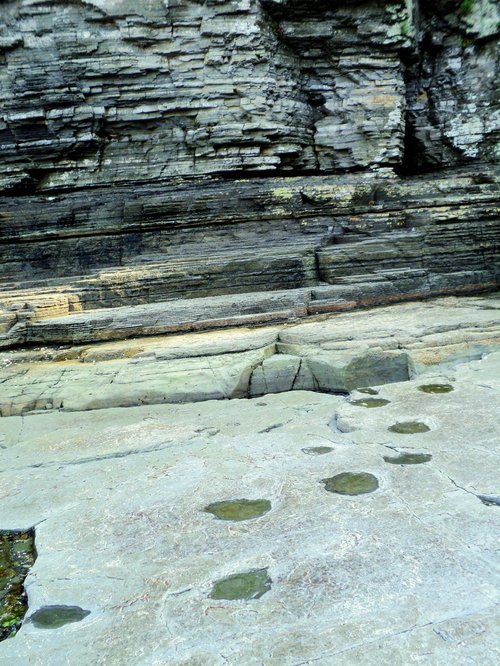The Korean Cretaceous Dinosaur Coast or (KCDC) was nominated under criterion (viii) in 2009. While the nomination was rejected by IUCN, more than a decade later more more dinosaur footprints have been found.
I visited the dinosaur footprints in Goseong (right next to a kid-friendly dinosaur museum). The dinosaur footprints are interesting and numerous, but the beauty of the rugged coast is likely the highlight for many casual visitors. I however was on a mission to see these footprints. I was glad I could make out the footprints and trackways; they are easy to spot because the footprints are usually filled with small pools of water, which comes with the change of tide. Not only were the footprints fairly easy to make out, it was possible to distinguish different dinosaur species amongst the footprints. As a serial property there are other significant footprint locations along the southern coast. I would certainly be interested in visiting additional locations. Despite the WHC rejection in 2009, these are enjoyable places to visit.

Below is a recent update:
From the Article "Korea is a paradise for dinosaur footprints" - December 2022
Context: On November 10th (2022), a press conference for the National Research Institute of Cultural Heritage was held at the National Palace Museum of Korea to mark the 40th anniversary of the discovery of dinosaur footprints. On this day, Martin Lockley, a professor at the University of Colorado in the U.S., a world authority in the field of dinosaur footprint fossils, answered a question asking about the difference between research on footprint fossils and bone fossils. Compared to other natural heritage sites, such as bone fossils, they have received less attention yet, but in fact, footprint fossils are very important clues that can unlock the secrets of creatures that lived in the past.
Q. Have you been to many fossil sites not only in Korea but also in Spain and Bolivia? What needs to be improved in order for Korea to be listed as a UNESCO Natural Heritage Site?
Prof. Lockley "It's almost perfect now. Looking at Bolivia, which is competing for the UNESCO natural heritage list, it is the world's largest fossil site, but it is very difficult to access without a rope because it is very steep. However, Korea ranks first in all aspects, including accessibility to fossil footprints, resistance to erosion, state of preservation, management at the government level, biodiversity, etc. 10 years ago, it was also number 1, and now it is completely number 1. That's why I'm looking forward to the future."
There are reports this serial nomination as organized will not seek to be included on Korea's new tentative list. However, the chances for a newly formulated nomination emerging in the years to come is certainly possible with new paleontological discoveries ongoing in South Korea. In fact, new national monuments (protecting fossilized dinosaur footprints) have been designated recently in Jinju (2011), Mokpo (2012), Gunsan (2014), and a second site in Jinju (2021). The later site in Jinju (recently discovered) has approximately 8,000 additional dinosaur footprints, which may apply for national geopark status. Lastly, an actual complete skeleton has now been discovered in Hadong County in 2014, a first in Korea. Another skeleton of a species now deemed "Koreaceratops" has also garnered attention in the past decade. Perhaps a re-configured nomination will emerge with 8-10 total serial components (compared to the 5 components in 2009). The work continues.
Flickr Album